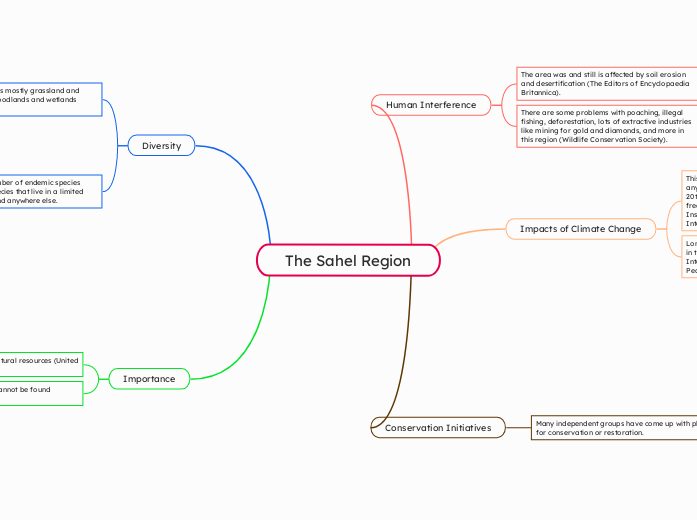The Sahel Region
Human Interference
The area was and still is affected by soil erosion and desertification (The Editors of Encyclopaedia Britannica).
Happened because of human populations that grew rapidly and needed more from the land (The Editors of Encyclopaedia Britannica).
There are some problems with poaching, illegal fishing, deforestation, lots of extractive industries like mining for gold and diamonds, and more in this region (Wildlife Conservation Society).
Impacts of Climate Change
This area has suffered the worst droughts of anywhere on the planet in the last quarter of the 20th century (Presse), as well an increase in the frequency and severity of floods (Norwegian Institute of International Affairs and Stockholm International Peace Research Institute).
Because of this, animals are also forced to migrate at times when they would usually not (Norwegian Institute of International Affairs and Stockholm International Peace Research Institute).
Long-term climate trends show a gradual increase in temperatures (Norwegian Institute of International Affairs and Stockholm International Peace Research Institute).
Conservation Initiatives
Many independent groups have come up with plans for conservation or restoration.
The Wildlife Conservation Society has many strategies that make up a full plan
These include:
- the research and monitoring of protected areas
- the creation of wildlife law enforcement programs to combat things like poaching
- plans to work with governments and international partners to provide guidance and support to influence development and promote green energy options
The Africa Biodiversity Collaborative Group has already implemented large scale rewilding and translocations.
An example is their rewilding in Chad, where there are now over 500 scimitar-horned oryx, which were extinct for almost 30 years.
Sahara Conservation also has some plans to conserve wildlife and ecosystems.
They plan to:
- recover declining species through reintroduction, research, and monitoring
- contribute to proper management of protected areas
Diversity
The land in the region is mostly grassland and savanna, with some woodlands and wetlands (Davies).
It contains a large number of endemic species (Davies), which are species that live in a limited area or cannot be found anywhere else.
Some of the species it supports includes the savanna and forest elephants, northern giraffe, lion, wild dog, cheetah, black and white rhino, and other large mammals (Wildlife Conservation Society).
Also supports hundreds of bird species like the shoebill and the crowned crane (Wildlife Conservation Society).
Importance
It has a lot of human and natural resources (United Nations).
This means it has a lot of potential for growth.
It has a lot of species that cannot be found anywhere else (Davies).
